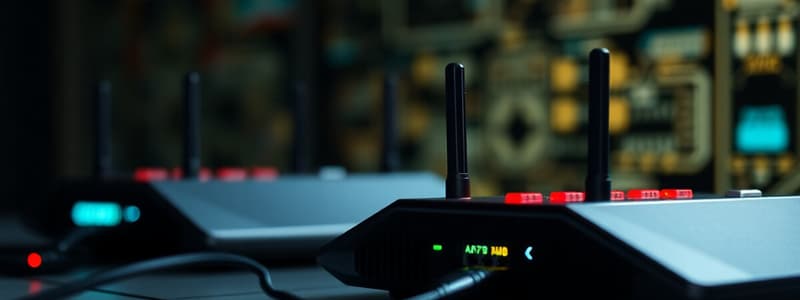Podcast
Questions and Answers
What frequency do microwave ovens operate at that overlaps with some wireless devices?
What frequency do microwave ovens operate at that overlaps with some wireless devices?
- 3.6GHz
- 5GHz
- 1.2GHz
- 2.4GHz (correct)
What should be consulted for optimum load capacity when too many users connect to the same access point?
What should be consulted for optimum load capacity when too many users connect to the same access point?
- User manual of the client device
- Local network regulations
- Router specifications
- Access point manufacturer documentation (correct)
What kind of IP address do access points typically assign to clients?
What kind of IP address do access points typically assign to clients?
- 192.168.0.x (correct)
- 10.0.0.x
- 192.168.1.x
- 172.16.0.x
What is the default channel for 802.11b and 802.11g routers?
What is the default channel for 802.11b and 802.11g routers?
Which wireless security protocol provides a higher level of security when connecting to public hotspots?
Which wireless security protocol provides a higher level of security when connecting to public hotspots?
What action should be taken if interference problems occur on an 802.11b or 802.11g router?
What action should be taken if interference problems occur on an 802.11b or 802.11g router?
What environmental factor can greatly affect the performance of a wireless signal?
What environmental factor can greatly affect the performance of a wireless signal?
What is the source port number of the TCP packet described?
What is the source port number of the TCP packet described?
Which of the following best describes the window size of the TCP packet?
Which of the following best describes the window size of the TCP packet?
What does a length of data packet being 0 indicate?
What does a length of data packet being 0 indicate?
Which port number is designated for FTP traffic?
Which port number is designated for FTP traffic?
What is indicated by the starting sequence number SEQ=997462768?
What is indicated by the starting sequence number SEQ=997462768?
What does it mean if there is no acknowledgement (ACK=0) in the packet?
What does it mean if there is no acknowledgement (ACK=0) in the packet?
How many packets are exchanged in the initial TCP handshake?
How many packets are exchanged in the initial TCP handshake?
Why might port 1054 be described as arbitrary?
Why might port 1054 be described as arbitrary?
What does the 'R' in ARP signify in the context of network communications?
What does the 'R' in ARP signify in the context of network communications?
What does the destination port indicate in the context of network communication?
What does the destination port indicate in the context of network communication?
In what scenario might a router provide a MAC address instead of the destination host in an ARP reply?
In what scenario might a router provide a MAC address instead of the destination host in an ARP reply?
Which of the following best describes the purpose of an ICMP source-quench packet?
Which of the following best describes the purpose of an ICMP source-quench packet?
What characteristic of the IGMP protocol allows data to be streamed to multiple hosts without acknowledgment?
What characteristic of the IGMP protocol allows data to be streamed to multiple hosts without acknowledgment?
What is one of the main applications of the ICMP protocol?
What is one of the main applications of the ICMP protocol?
What is the primary purpose of an IP address in a network?
What is the primary purpose of an IP address in a network?
How is the network portion of an IP address similar to a telephone number?
How is the network portion of an IP address similar to a telephone number?
What does an ARP request do within a local area network?
What does an ARP request do within a local area network?
What does the term 'BROADCAST' mean in the context of an ARP request?
What does the term 'BROADCAST' mean in the context of an ARP request?
What role does the host address portion of an IP address play?
What role does the host address portion of an IP address play?
Which of the following describes an ARP reply?
Which of the following describes an ARP reply?
How does the hardware address relate to the IP address during data transmission?
How does the hardware address relate to the IP address during data transmission?
What is the purpose of the ARP protocol in networking?
What is the purpose of the ARP protocol in networking?
Which statement correctly distinguishes the functions of the network and host portions of an IP address?
Which statement correctly distinguishes the functions of the network and host portions of an IP address?
Which component of an ARP request identifies the source equipment sending out the request?
Which component of an ARP request identifies the source equipment sending out the request?
What is the primary characteristic of UDP compared to TCP?
What is the primary characteristic of UDP compared to TCP?
During the TCP connection closure process, which packet type is sent to indicate the termination of communication?
During the TCP connection closure process, which packet type is sent to indicate the termination of communication?
Which protocol is responsible for addressing and routing packets in the TCP/IP model?
Which protocol is responsible for addressing and routing packets in the TCP/IP model?
What happens when a UDP packet transfer occurs regarding acknowledgments?
What happens when a UDP packet transfer occurs regarding acknowledgments?
What typically occurs to terminate a UDP data transfer?
What typically occurs to terminate a UDP data transfer?
Which statement about the packets 138, 139, and 140 during the UDP transfer is accurate?
Which statement about the packets 138, 139, and 140 during the UDP transfer is accurate?
What is one major advantage of using UDP in applications like videoconferencing?
What is one major advantage of using UDP in applications like videoconferencing?
Which of the following protocols is NOT part of the TCP/IP Internet Layer?
Which of the following protocols is NOT part of the TCP/IP Internet Layer?
What action occurs after a FIN packet is sent by a host?
What action occurs after a FIN packet is sent by a host?
Which characteristic of UDP is highlighted by its lack of acknowledgment?
Which characteristic of UDP is highlighted by its lack of acknowledgment?
Flashcards
Microwave Oven Frequency
Microwave Oven Frequency
Microwave ovens operate at 2.4 GHz, overlapping with 802.11b/g/n Wi-Fi devices.
Wi-Fi Load Issues
Wi-Fi Load Issues
Too many devices connecting to the same access point at once can cause slowness and dropped packets.
DHCP IP Addresses
DHCP IP Addresses
Access points assign IP addresses (like 192.168.0.x) to connected devices.
SSID Reconfiguration
SSID Reconfiguration
Signup and view all the flashcards
Wi-Fi Security Protocols
Wi-Fi Security Protocols
Signup and view all the flashcards
Selecting Wireless Channels
Selecting Wireless Channels
Signup and view all the flashcards
Extending Wi-Fi Range
Extending Wi-Fi Range
Signup and view all the flashcards
TCP Packet
TCP Packet
Signup and view all the flashcards
Source Port (SP)
Source Port (SP)
Signup and view all the flashcards
Destination Port (DP)
Destination Port (DP)
Signup and view all the flashcards
Well-Known Port
Well-Known Port
Signup and view all the flashcards
Sequence Number (SEQ)
Sequence Number (SEQ)
Signup and view all the flashcards
Acknowledgement (ACK)
Acknowledgement (ACK)
Signup and view all the flashcards
Data Packet Length (LEN)
Data Packet Length (LEN)
Signup and view all the flashcards
Window Size (WS)
Window Size (WS)
Signup and view all the flashcards
Initial TCP Handshake
Initial TCP Handshake
Signup and view all the flashcards
TCP Connection Closure
TCP Connection Closure
Signup and view all the flashcards
UDP: Connectionless
UDP: Connectionless
Signup and view all the flashcards
UDP Use Cases
UDP Use Cases
Signup and view all the flashcards
UDP Packet Transfer
UDP Packet Transfer
Signup and view all the flashcards
No Acknowledgements in UDP
No Acknowledgements in UDP
Signup and view all the flashcards
Internet Layer
Internet Layer
Signup and view all the flashcards
IP
IP
Signup and view all the flashcards
ARP
ARP
Signup and view all the flashcards
ICMP
ICMP
Signup and view all the flashcards
IGMP
IGMP
Signup and view all the flashcards
What is IP?
What is IP?
Signup and view all the flashcards
What are the parts of an IP address?
What are the parts of an IP address?
Signup and view all the flashcards
What is ARP?
What is ARP?
Signup and view all the flashcards
What is a MAC address?
What is a MAC address?
Signup and view all the flashcards
How does ARP work?
How does ARP work?
Signup and view all the flashcards
What is an ARP request?
What is an ARP request?
Signup and view all the flashcards
ARP Reply
ARP Reply
Signup and view all the flashcards
Multicasting
Multicasting
Signup and view all the flashcards
What is an ARP reply?
What is an ARP reply?
Signup and view all the flashcards
IGMP Protocol
IGMP Protocol
Signup and view all the flashcards
How does ARP help with data delivery?
How does ARP help with data delivery?
Signup and view all the flashcards
What is the purpose of BROADCAST in ARP?
What is the purpose of BROADCAST in ARP?
Signup and view all the flashcards
Streaming
Streaming
Signup and view all the flashcards
ICMP Source-Quench Packet
ICMP Source-Quench Packet
Signup and view all the flashcards
What is PA in an ARP request?
What is PA in an ARP request?
Signup and view all the flashcards
Study Notes
Chapter 4-4: Bluetooth, WiMAX, RFID, and Mobile Communications
- This chapter covers three wireless technologies: Bluetooth, WiMAX, and RFID.
- Each technology plays a role in wireless networks, with a focus on configuration and hardware examples.
Introduction
- The section examines three different wireless technologies: Bluetooth, WiMAX, and RFID.
- These technologies play significant roles in wireless networks.
- Each technology is examined with a look at configuration and examples of the hardware used.
Bluetooth
- Bluetooth is based on the 802.15 standard.
- It was designed to replace wired connections between computers, mobile phones, handheld devices, and other electronic devices.
- Information transmission occurs over the 2.4 GHz ISM frequency band, which is also used by 802.11b, g, n.
- Three output power classes exist for Bluetooth devices:
- Class 1: ~100 meters range, 20 dBm output power
- Class 2: ~10 meters range, 4 dBm output power
- Class 3: ~1 meter range, 0 dBm output power
Inquiry Procedure
- An inquiry procedure is used by a Bluetooth device when enabled to detect available Bluetooth devices.
- This procedure also allows the device to be discovered.
Bluetooth - Continued
- A discovered Bluetooth device sends an inquiry reply back to the initiating device.
- The paging procedure establishes and synchronizes connection between two Bluetooth devices.
- Bluetooth devices establish a piconet, an ad hoc network of up to eight devices.
- One device (master) provides synchronization, other devices (slaves) follow.
WiMAX
- WiMAX (Worldwide Interoperability for Microwave Access) is a broadband wireless system.
- It's designed for broadband wireless access (BWA) for fixed and mobile stations.
- WiMAX can provide last-mile broadband access in the 2 GHz to 66 GHz frequency range.
- BWA for fixed stations has a range of up to 30 miles, while mobile BWA has a range of 3-10 miles.
- Internationally, the WiMAX frequency standard is 3.5 GHz, while the United States utilizes both unlicensed 5.8 GHz and licensed 2.5 GHz spectrum.
WiMAX - Continued
- WiMAX provides flexible channel sizes (e.g., 3.5 MHz, 5 MHz, and 10 MHz), enabling adaptability to worldwide standards.
- This flexibility helps ensure maximum data transfer rate support.
- An example illustrates that the allocated channel bandwidth of 6 MHz allows WiMAX to adjust and utilize the entire bandwidth.
- The WiMAX (IEEE 802.16e) media access control (MAC) layer differs from the IEEE 802.11 Wi-Fi MAC layer.
- This approach to MAC access allows for scheduled access to the network, and a collision-free environment improving channel throughput.
WiMAX - Continued
- WiMAX operates in a range of up to 31 miles and can function in both point-to-point and point-to-multipoint configurations.
- It proves beneficial in situations lacking DSL or cable network connections.
- The last mile connection, from the provider to the customer, can be costly, making wireless alternatives like WiMAX attractive.
RFID
- RFID (Radio Frequency Identification) is a technique utilizing radio waves to track and identify people, animals, objects, and shipments.
- RFID works using the principle of modulated backscatter.
- The term "backscatter" refers to the reflection of radio waves from an RFID tag.
- The tag reflects the information stored within it back to the transmitter source.
RFID System
- The RFID system comprises two main components:
- RFID tag (also called an RF transponder): contains an integrated antenna and radio electronics.
- Reader (or transceiver): a combination of a transmitter and receiver; includes a transceiver and an antenna.
- The reader transmits radio waves to activate the tag.
- The tag transmits modulated data, containing its unique identification information, back to the reader.
- The reader extracts the data from the tag.
RFID Tag
- The RFID tag includes an antenna and integrated circuitry on a substrate.
RFID System - Parameters
- Three parameters define an RFID system:
- Means of powering the tag
- Frequency of operation
- Communications protocol (also called the air interface protocol)
Powering the Tag
- RFID tags are classified by their power source: passive, semi-active, and active.
- Passive tags derive power from the reader's RF energy.
- Semi-active tags are powered by batteries and use backscatter for transmission.
- Active tags use batteries to transmit a signal back to the reader.
Frequency of Operation
- RFID tags are tuned to the reader's transmit frequency for operation.
- RFID systems generally use three frequency bands for operation: Low Frequency (LF), High Frequency (HF), and Ultra-High Frequency (UHF).
- LF tags use FSK, typically 125/134 kHz; their data rate is low (~12 kbps), and they're suitable for animal tracking.
- HF tags operate at 13.56 MHz with a short (1 meter) read range—used for access control, smart cards, and shelf inventory. The data rate is ~26 kbps.
- UHF tags operate at 860-960 MHz and 2.4 GHz with data rates of 50-150 kbps, suitable for tracking inventory. A read range of 10–20 feet is possible with passive UHF; up to 100 meters for active tags.
Communication Protocol
- RFID tags use the Slotted Aloha protocol for communication.
- This technique determines when tags are allowed to transmit, thereby reducing data collisions and enabling the reading of up to 1000 tags per second.
Mobile Communications
- This section provides a summary of other wireless technologies currently available:
- CDMA (Code Division Multiple Access): a spread-spectrum communications system.
- LTE (Long Term Evolution): a 4G standard delivering up to 10 times the speed of 3G networks.
- HSPA+ (Evolved High-Speed Packet Access): a protocol providing network speeds comparable to LTE networks.
- 3G/4G (3rd and 4th Generation): standards defining 3G wireless communications as International Mobile Communications (IMT-2000).
- Edge (Enhanced Data GSM Evolution): a protocol providing 384 kbps download speeds.
Chapter 4-4 Key Terms
- Inquiry procedure
- Paging procedure
- Piconet
- Last mile
- Backscatter
- RFID tag
- Reader
- Slotted Aloha
Chapter 4-5: Configuring a Point-to-Point Wireless LANs - A Case Study
- This section demonstrates an example for preparing a proposal for a point-to-multipoint wireless network for a company.
- Company administrators want a wireless connection for employees to the company network.
Overview
- This example problem covers these issues:
- Initial antenna site survey
- Establishing a link from the company network to the distribution point
- Configuring the multipoint distribution
- RF site survey (baseline signal level for remote wireless user)
- Configuring the user setup
Antenna Site Survey
- The proposed antenna is on a hill approximately 1 km from the main network site.
- A survey revealed a tower suitable for mounting the wireless antenna.
- A clear view of the surroundings exists for a range of 6 km in any direction.
- No wired network setup for connection back to the main network is available.
- A small building housing the equipment is available.
- The site includes available rack space for the wireless network gear.
Establishing a Point-to-Point Wireless Link to the Home Network
- The plan is to establish an 11 Mbps link between the new antenna site and the main network.
- The issue is the cost involved in the link to the main network.
Antenna Selection
- Possible antennas for the wireless network are Omni, Yagi, and Dish.
- Table 4-4 lists characteristics including radiation pattern range, speed, and cost.
- This table lists descriptions of the Omni directional, directional (Yagi), and highly directional antennas (Dish).
- The Omni Antenna, Yagi Antenna, and Dish Antenna diagrams with their radiation patterns are described.
Configuring the Antenna Site for Multipoint Distribution
- An 11 Mbps wireless data link from the antenna site to the main network is established.
- A 2 Mbps link was chosen for adequate coverage for remote users.
- Survey results from step I show a clear view for 12 km, with 6 km in each direction.
- The Omni directional antenna (Antenna A) satisfies the 7km required coverage area and the 2 Mbps data rate.
Configuring the Site
- Omni directional antenna (Antenna A) is mounted on the antenna site tower.
- An RF site survey is conducted to verify the signal quality from the selected antenna.
- Measurements from multiple locations within the targeted coverage area were obtained.
- The software for the site survey is shown (Intel(R) PROSet II).
V. Configuring the Remote User Installation
- The remote user's antenna needs to be able to clearly see the main network's antenna.
- Requirements for the remote user client:
- 2 Mbps data rate connection
- Directional antenna (Yagi)
- Mounting system, lightning arrestor, and a wireless bridge
Other Wireless Networking Technologies.
- Briefly describe other wireless technologies (CDMA, LTE, HSPA+, 3G/4G, Edge.)
Chapter 4 Summary
- Wireless networking technologies are now easy to integrate into existing networks.
- A network administrator's main goal is a fast, reliable, and secure network.
- Careless integration of wireless components can negatively affect the network's security and reliability.
- Key wireless networking concepts are important when reading the material such as the operating characteristics of the 802.11 networks, the purpose of access points, wireless LAN adapters, and wireless bridges, performing a basic site survey on a building, configuring the network for user mobility, and planning a multipoint wireless distribution.
Ch. 4 Summary
- New wireless network technologies have simplified network planning and installation.
- RF interference and noise are possible risks, emphasizing the importance of RF planning.
- Well-structured RF installations require comprehensive studies and identification of potential interfering sources.
- Obtaining support for RF-related needs is essential part of wireless installation.
Chapter 4-6: Troubleshooting Wireless Networks
- The chapter focuses on common techniques for troubleshooting wireless networks.
- Wireless networks are relatively easy to set up but intermittent failures can occur.
- The chapter outlines various scenarios and steps to resolve wireless issues.
Troubleshooting Hardware Issues
- The primary hardware device is the access point.
- Ping the access point's IP address to verify network connectivity.
- If pinging fails, unplugging and replugging the access point often resets it.
- Other hardware components may cause issues if identified.
Troubleshooting Signal Strength Problems
- Measuring the signal strength verifies the signal level at the receiving location.
- Reduced signal strength may not be an access point issue, but rather physical obstructions like moved objects.
Troubleshooting Frequency Interference
- Microwaves operate at the same frequency (2.4 GHz) as 802.11b/g/n devices, potentially causing interference.
- Baseline signal strength measurements at various locations help diagnose interference.
Troubleshooting Load Issues
- Wireless users share a common frequency channel with the same access point.
- High user load leads to slower speeds and packet drops.
- Optimal load capacity depends on the access point manufacturer's specifications.
Troubleshooting DHCP Issues
- Access points typically assign a 192.168.0.x address to clients.
- Use the ipconfig command on the client to check the assigned IP address.
Troubleshooting SSID Issues
- SSIDs (Service Set Identifiers) configured to a device do not ordinarily need reconfiguration.
- Re-configuring an SSID for a different network may be necessary. Returning to one's home network requires resetting to the original SSID.
Troubleshooting Securing Wi-Fi
- Multiple network security protocols (e.g. different versions of WPA/WEP) are generally supported by wireless networks.
- Ensuring consistent security modes (client and access point) is essential.
- Public Wi-Fi hotspots create security risks and are susceptible to packet sniffing attacks.
- Enabling WPA is effective in safeguarding data traffic on public networks.
Troubleshooting Selecting Wireless Channels
- The default channel for 802.11b and 802.11g routers is channel 6.
- Changing the channel to 1 or 11 can resolve interference.
- Channels 1 and 11 do not overlap in the RF spectrum.
- Some wireless routers allow selection of a different channel.
Troubleshooting Extending the Wireless Range
- Place antennas in high locations, keeping them away from metal objects that would obstruct the signal propagation.
- Radio waves reflect off metal surfaces and may weaken the signal.
- Using high-gain antennas boosts receive signal strength in situations where concrete or brick obstacles are present.
Troubleshooting Wireless Compatibility
- Not all wireless clients are equal, hardware and software vary.
- Compatible standards (access point and wireless clients) are necessary for high throughput.
- 802.11n supports both 2.4 GHz and 5 GHz.
Troubleshooting Cable Issues
- Wireless issues may sometimes originate from simple physical connections.
- Ensure the cable is securely connected or replace the cable if necessary.
- Verify the connection by checking for a link light.
Troubleshooting Switch Uptime
- Network technicians use switch uptime to diagnose potential problems.
- The show version command on the switch provides details about uptime.
- Occasional switch reboots may be due to power fluctuations or switch-related issues.
Chapter 6-2: The TCP/IP Layers
- This chapter details the framework for the TCP/IP model.
- This model has four layers: Application, Transport, Internet, and Network Interface.
- The application layer handles application-specific details.
- The transport layer defines the connection types.
- The internet layer governs addressing and routing.
- The network interface layer handles network connectivity methods.
TCP/IP Layers - Continued
- The TCP/IP protocol was developed before the OSI model.
- The four layers in the TCP/IP model correspond to the seven layers in the OSI model.
Table 6-2: Port Number Assignments
- Port numbers 1-1023 are well-known ports.
- Ports 1024-49151 are registered ports.
- Ports 49152-65535 are private ports.
- ICANN (Internet Corporation for Assigned Names and Numbers) reserves appropriate network ports.
Table 6-3: Common Applications and their Port Numbers
- Various applications utilize distinct port numbers for communication.
Transport Layer
- The Transport layer protocols in TCP/IP establish, manage, and close network connections.
- Two transport protocols exist: TCP (connection-oriented) and UDP (connectionless).
- TCP establishes the connection, manages data transfer, and terminates the connection.
- TCP includes error checking and recovery procedures.
- A unique three-packet exchange sequence initiates TCP connection: SYN, SYN+ACK, and ACK.
TCP Connection Handshake
- The initial TCP connection involves three data packets: SYN (Synchronizing), SYN+ACK (Synchronizing + Acknowledgement), and ACK (Acknowledgement).
- Specific sequence numbers (SEQ#) and acknowledgement numbers (ACK#) within each packet are key.
- The procedure shows how computers verify the connection request to ensure reliable data transfer and delivery.
TCP Packet Transmission
- Example of a TCP connection captured by a protocol analyzer.
- This shows the established connection between Host A (client) and Host B (server), and also includes example packet information in a table format.
TCP Handshake - Continued
- The Summary information for each packet is provided in the table.
UDP (User Datagram Protocol)
- UDP is a connectionless protocol.
- UDP packets are transported over the network without establishing a connection or sending acknowledgements.
- UDP is suitable for applications like videoconferencing and audio.
The Internet Layer
- The TCP/IP Internet Layer defines the protocols for addressing and routing data packets.
- Key protocols include IP (Internet Protocol), ARP (Address Resolution Protocol), ICMP (Internet Control Message Protocol), and IGMP (Internet Group Management Protocol).
IP (Internet Protocol)
- IP is responsible for identifying the source and destination addresses used for data delivery on a network.
- IP address consists of a network address and a host address.
- The network part directs data to the proper network portion; the host part identifies the local device in the network.
ARP (Address Resolution Protocol)
- ARP resolves an IP address into a hardware address (MAC address) for final delivery of data packets.
- ARP requests are broadcast on a local area network (LAN) to find the MAC address associated with a specific IP address.
- The device with the corresponding IP address responds with an ARP reply, providing the MAC address.
ICMP (Internet Control Message Protocol)
- ICMP is used for network control, error reporting, and diagnostics.
- The ping command uses ICMP to verify connectivity with a host.
IGMP (Internet Group Management Protocol)
- IGMP is a protocol enabling one host to send data to multiple hosts (multicasting).
- Multicast addresses are reserved addresses that aren't assigned to hosts in a network.
- Multicasting is used by routers exchanging routing tables.
- Streams of data transmissions are unaffected by the delivery confirmation since the sender of data is not waiting for the confirmation to proceed.
The Network Interface Layer
- The Network Interface Layer of the TCP/IP model defines how a host connects to the network.
- A host can be a computer on an Ethernet or Token-Ring network.
- A host can also be a router connected to a frame-relay wide area network.
IPv4 Addressing
- IPv4 uses 32-bit addresses categorized into classes A, B, C, D, and E.
- Each class has its own set of address ranges.
- Private IP addresses are not used for Internet traffic but are reserved for use on internal networks (e.g., Intranet).
- ARIN (American Registry for Internet Numbers) assigns IP address space to Internet Service Providers (ISPs) and end users. Only qualifying organizations receive blocks of addresses.
Section 6-4 Key Terms
- IPv4 addressing classes (A, B, C, D, E)
- Non-routable IP addresses
- ARIN
Chapter 6-5: Subnet Masks
- Subnetting divides networks into smaller subnets.
- The subnet mask identifies bits in the IP address representing network/subnet portions.
- Subnets are created by borrowing bits from the host portion of the IP address.
Additional Subnetting Information
- Calculations show how subnets reduce available hosts, but expand the addressing possibilities.
- Specific methods for identifying network and subnet addresses are described.
- Examples are provided for calculations regarding the number of bits to be borrowed from the hosts portion to create an appropriate subnet mask, including the resulting subnet addresses and broadcast addresses.
Other IPv6 Information
- Key features of IPv6:
- Large address space
- Stateless address autoconfiguration (SLAAC)
IPv6 Transition
- The transition to IPv6 is gradual and is currently underway.
- Network systems are incorporating the IPv6 protocol to prepare for the transition.
Section 6-7 Key Terms
- IPv6, IPng, Full IPv6 addresses
Studying That Suits You
Use AI to generate personalized quizzes and flashcards to suit your learning preferences.




